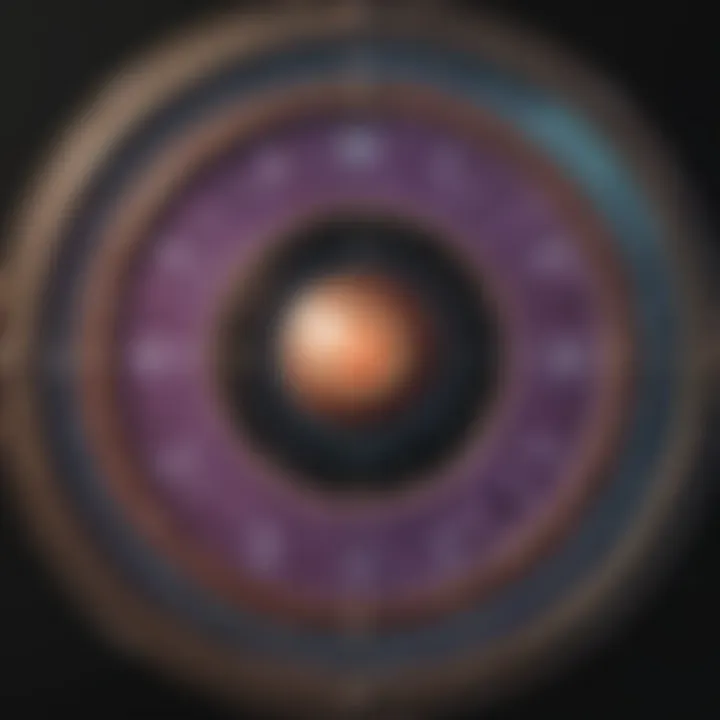Understanding Birth Charts: Insights into Your Celestial Self


Intro
Astrology serves as a timeless guide to understanding oneself and the universe. Central to this practice are birth charts, which map the positions of celestial bodies at the moment of one's birth. These charts provide insights into an individual's personality, potential life paths, and inherent challenges. To fully grasp the implications of a birth chart, it is crucial to examine the various components that make up this intricate tool.
Zodiac Profiles
Overview of Each Sign
The zodiac consists of twelve signs, each representing distinct personality traits and characteristics. These signs are categorized based on the position of the sun at the time of birth. Here are brief descriptions of each sign in the zodiac:
- Aries: Known for their assertiveness and enthusiasm.
- Taurus: Grounded individuals with a love for stability.
- Gemini: Communicative and versatile in nature.
- Cancer: Emotional, caring, and nurturing.
- Leo: Natural leaders with a flair for drama.
- Virgo: Detail-oriented and analytical thinkers.
- Libra: Seek balance and harmony in relationships.
- Scorpio: Intense and perceptive, with strong emotions.
- Sagittarius: Adventurous spirits that crave exploration.
- Capricorn: Ambitious and disciplined in their pursuits.
- Aquarius: Innovators who favor independence.
- Pisces: Empathetic and artistic individuals.
Personality Traits
Each sign carries unique personality traits shaped by its elemental association and ruling planet. Understanding these traits can help individuals recognize their strengths and weaknesses, leading to personal growth and development.
- Fire Signs: (Aries, Leo, Sagittarius) are typically energetic, passionate, and full of vitality. They are known for their enthusiasm and can sometimes be impulsive.
- Earth Signs: (Taurus, Virgo, Capricorn) are grounded, practical, and reliable. They have a strong connection to the physical world, often valuing tradition and stability.
- Air Signs: (Gemini, Libra, Aquarius) are social, intellectual, and communicative. They thrive on interaction and can adapt quickly to new ideas and changes.
- Water Signs: (Cancer, Scorpio, Pisces) are intuitive, emotional, and sensitive. They often possess deep feelings and can easily empathize with others.
Strengths and Weaknesses
Every zodiac sign has its strengths and weaknesses. Acknowledging these can enhance self-awareness and foster better interpersonal relationships.
- Aries: Strength: Courageous. Weakness: Impulsive.
- Taurus: Strength: Determined. Weakness: Stubbornness.
- Gemini: Strength: Adaptable. Weakness: Indecisive.
- Cancer: Strength: Protective. Weakness: Moody.
- Leo: Strength: Generous. Weakness: Arrogant.
- Virgo: Strength: Meticulous. Weakness: Overcritical.
- Libra: Strength: Diplomatic. Weakness: Indecisive.
- Scorpio: Strength: Resourceful. Weakness: Jealousy.
- Sagittarius: Strength: Open-minded. Weakness: Tactless.
- Capricorn: Strength: Responsible. Weakness: Pessimistic.
- Aquarius: Strength: Independent. Weakness: Unpredictable.
- Pisces: Strength: Compassionate. Weakness: Escapist.
Compatibility Insights
Love and Relationships
Astrology plays a crucial role in understanding romantic compatibility. Pairing zodiac signs can reveal strengths and challenges in relationships. Some combinations may enhance attraction and understanding, while others could lead to conflicts. For instance, fire signs usually connect well with air signs, as air feeds fire's energy, whereas earth signs may find balance with water signs.
Friendship Compatibility
Friendships often grow through common interests and complementary traits. Air signs tend to bond easily due to their social nature, while earth signs may appreciate the reliability in relationships with fellow earth signs. Understanding friendship dynamics through astrology can nurture stronger bonds.
Workplace Dynamics
Astrology can also shed light on professional relationships. Compatibility in the workplace means recognizing effective collaboration. Fire signs often inspire motivation, while earth signs provide stability, leading to productive teamwork.
Astrological Events
Monthly/Weekly Horoscope Breakdown
Horoscopes help individuals navigate their lives based on current celestial positions. Monthly and weekly forecasts can offer guidance for daily activities and long-term planning, helping to align personal goals with planetary influences.
Notable Celestial Events
Awareness of celestial events, such as eclipses and retrogrades, can prepare individuals for shifts in energies. These events may signify opportunities for change or moments of reflection. Planning around these periods can yield beneficial outcomes.
How to Prepare for Astrological Shifts
Preparation for astrological shifts involves understanding how different signs are affected by planetary movements. Strategies may include self-reflection, meditation, or journaling, allowing individuals to adapt more effectively to the energy changes.
Understanding your birth chart and the influences of celestial events offers valuable insights to navigate life's complexities.
Prelims to Birth Charts
Definition and Importance
Birth charts, also known as natal charts, serve as a personalized map of the heavens at the exact moment and place of an individual's birth. These charts plot the location of celestial bodies, including the sun, moon, and planets, across the twelve astrological signs and houses. Understanding these charts is crucial, as they provide insights into one's personality, potential life path, and inherent challenges. People often wonder how their birth charts relate to their lifelong experiences and actions. This article delves into the essential elements that shape an individual's astrological profile, opening doors to deeper self-awareness.
The importance of birth charts transcends basic astrology. They act as formative tools that unveil significant traits, preferences, and inherent strengths. When people engage with their birth charts, they often find clarity and direction, enhancing their understanding of personal dynamics and life choices. The transformative potential of this knowledge cannot be overstated. By grasping one's astrological framework, individuals can harness insights that help navigate complexities in various aspects of life.
Overview of Astrological Elements


Astrological elements are the foundational concepts that shape the interpretation of birth charts. They encompass various components that work together holistically. Key elements include zodiac signs, planetary positions, houses, and aspects. Each of these elements provides a unique lens through which to view an individual's potential and challenges.
- Zodiac Signs: Each sign represents specific characteristics and motivations. Understanding the attributes of each sign is vital for interpreting one's sun, moon, and rising signs.
- Planetary Positions: The positions of celestial bodies in the zodiac signs reveal nuances in personality and influence the overall energy of the birth chart.
- Houses: The twelve houses correspond to different life areas, such as career, relationships, and home. Each house's placement can significantly impact life experiences.
- Aspects: These are the angles formed between planets in the chart. Understanding aspects can clarify how different parts of the personality interact with one another.
By gaining familiarity with these elements, the reader can further appreciate how they connect and manifest within a birth chart. This foundational knowledge paves the way for deeper exploration of the key components that form the essence of astrology.
Key Components of a Birth Chart
Understanding the key components of a birth chart is essential because these elements form the foundation of astrological analysis. Each component reveals different layers of personality and potential life events. Grasping their significance not only enriches one's understanding of oneself but also enhances the interpretation of relationships and life trends.
Sun Sign
The sun sign is arguably the most recognized aspect of a birth chart. It represents the core of an individual’s personality, encompassing fundamental traits and core motivations. The sun sign is determined by the position of the sun at the time of one's birth and is often seen as a person's main identity.
Commonly referred to in general astrology, sun signs can be grouped into four basic elements: fire, earth, air, and water. Each group has distinct characteristics that influence behavior and thinking patterns. For example, fire signs, such as Aries and Leo, embody enthusiasm and passion, while earth signs, like Taurus and Virgo, value stability and practicality. Understanding one’s sun sign enriches the self-awareness journey.
Moon Sign
The moon sign embodies emotions and instinctual responses. While the sun sign speaks about the outward persona and conscious self, the moon sign dives deeper into the subconscious. It reflects how one handles emotions, experiences joy, and copes with stress. The positioning of the moon in relation to other celestial bodies at birth provides insights into personal relationships and emotional needs.
The moon sign is sensitive and fluid. People with a strong moon influence often experience significant mood swings depending on their environment. For example, a Cancer moon is nurturing and seeks emotional security, whereas an Aquarius moon may appear detached, valuing independence over emotional entanglement. Recognizing the moon sign creates a fuller picture of emotional tendencies and relational dynamics.
Rising Sign (Ascendant)
The rising sign, also known as the Ascendant, represents how individuals present themselves to the world. It is the zodiac sign that was rising on the eastern horizon at the time of birth. The rising sign influences first impressions and the way people interact with outsiders.
Those with a Sagittarius rising, for instance, may come off as adventurous and open, attracting attention with their enthusiasm. In contrast, a Capricorn rising may be perceived as reserved or disciplined. This ascendant is significant as it affects behavior, appearance, and life approach. Understanding one’s rising sign can lead to greater insight into personal interactions and public persona.
Each component of a birth chart is interconnected. Analyzing the relationship between the sun, moon, and rising signs can unveil deeper insights.
Consideration of these three key components—sun sign, moon sign, and rising sign—forms a comprehensive view of one’s astrological profile. They enable astrology enthusiasts to explore the nuances of personality, emotions, and social presence, thereby enriching both personal growth and interpersonal relationships.
Understanding the Zodiac Signs
Understanding the Zodiac Signs is a fundamental aspect of astrology, providing invaluable insights into individual personalities and interpersonal dynamics. Each sign represents unique traits, tendencies, and challenges that characterize those born under its influence. By analyzing these signs, individuals can grasp not only their own behaviors but also the nuances of relationships with others.
Characteristics of Each Zodiac Sign
Each of the twelve zodiac signs offers distinct characteristics that shape a person's behavior and emotions. Here is a brief overview:
- Aries (March 21 - April 19): Known for their assertiveness and passion, Aries individuals exhibit leadership qualities and enthusiasm.
- Taurus (April 20 - May 20): They value stability and comfort, often being practical and reliable in their relationships.
- Gemini (May 21 - June 20): Geminis are adaptable and curious, possessing strong communication skills and a love for variety.
- Cancer (June 21 - July 22): Deeply intuitive, Cancer individuals are nurturing and sensitive to the needs of others.
- Leo (July 23 - August 22): They are charismatic and creative, often seeking appreciation and recognition.
- Virgo (August 23 - September 22): Virgos are detail-oriented and analytical, focused on practicality and service to others.
- Libra (September 23 - October 22): Known for their pursuit of harmony, Libras value relationships and often seek balance in their lives.
- Scorpio (October 23 - November 21): Scorpios are intense and passionate, often exhibiting determination and emotional depth.
- Sagittarius (November 22 - December 21): Free-spirited and adventurous, Sagittarians crave knowledge and exploration.
- Capricorn (December 22 - January 19): Ambitious and disciplined, Capricorns work hard to achieve their goals, valuing tradition.
- Aquarius (January 20 - February 18): Aquarians are innovative and progressive, often focusing on social issues and human rights.
- Pisces (February 19 - March 20): Known for their creativity and empathy, Pisces individuals are often deeply sensitive and imaginative.
Understanding these traits allows astrology enthusiasts to appreciate the diversity among individuals. Each sign contributes to the rich fabric of human experiences, shaping personalities in diverse ways.
Compatibility Among Zodiac Signs
Compatibility in astrology refers to how well different signs interact with each other. While every pairing has potential, certain signs tend to complement one another more effectively than others. For instance:
- Aries and Leo: Often create dynamic and passionate relationships due to their shared enthusiasm.
- Taurus and Virgo: Tend to build strong connections based on mutual values and stability.
- Gemini and Aquarius: Nurture intellectually stimulating relationships filled with creativity.
- Cancer and Pisces: Often form emotionally supportive partnerships with deep understanding.
On the other hand, some combinations may face challenges. Aries and Cancer, for example, might struggle due to differing needs for independence and security. Recognizing these compatibility patterns can enhance relationship dynamics, leading to better understanding.
The Twelve Houses of Astrology
The twelve houses are fundamental to astrology, providing a framework that categorizes different areas of life. Understanding these houses can offer profound insights into how celestial influences manifest in various aspects of an individual's experiences. Each house relates to specific themes, from personal identity and relationships to career and spirituality. This depth of understanding empowers astrology enthusiasts to navigate their birth charts with greater clarity.
Meaning of Each House
Each house in astrology represents distinct aspects of life. Here is a brief overview of what each house signifies:
- First House: This house represents self-image, personality, and immediate environment. It often reflects how individuals present themselves to the world.
- Second House: Focuses on personal finances, possessions, and values. It speaks to material security and self-worth.
- Third House: Governs communication, intellect, and local travel. It relates to how people process information and connect with their environment.
- Fourth House: This house deals with home, family, and emotional foundations. It reveals the person's roots and their relationship with their upbringing.
- Fifth House: Represents creativity, romance, and self-expression. It encompasses activities such as hobbies and child-rearing.
- Sixth House: Related to health, daily routines, and service. It indicates how individuals approach work and wellness.
- Seventh House: Governs partnerships and relationships, particularly marriage. It reflects the way individuals interact with others on a personal level.
- Eighth House: Focuses on transformation, shared resources, and intimacy. It dives into life-and-death matters, including inheritances and deep emotional bonds.
- Ninth House: This house represents philosophy, higher education, and travel. It often reflects a person's beliefs and the pursuit of knowledge.
- Tenth House: Governs career, reputation, and public life. It illustrates how individuals are seen professionally and their ambitions.
- Eleventh House: Related to friendships, community, and aspirations. It highlights social networks and long-term goals.
- Twelfth House: This house represents the unconscious, spirituality, and hidden matters. It often reveals what lies beneath the surface of an individual's life.
How Houses Influence Different Life Areas


The influence of houses extends across many aspects of daily life. They reveal how different areas are impacted by astrological elements present in a birth chart.
- Life Themes: Each house brings forth particular themes. For instance, the fourth house may highlight family dynamics, while the tenth house may reveal career aspirations.
- Planetary Positions: The planets located within these houses provide insight into how these life areas are experienced. For example, having Venus in the seventh house may suggest a strong focus on relationships.
- Transits and Progressions: Astrology is not static. Planetary transits through houses can point to times of change or growth in specific life areas. Understanding this movement can guide individuals through personal challenges and opportunities.
“The cosmos is within us. We are made of star-stuff. We are a way for the universe to know itself.” – Carl Sagan
And so, exploring the meaning of each house further enhances one's ability to interpret their personal astrological map and leads to greater self-awareness.
Aspects in Astrology
Understanding aspects is vital when analyzing birth charts. Aspects refer to the angular relationships between planets in a chart. They provide insights into how celestial bodies interact, influencing personality traits, emotional responses, and life events. By understanding these relationships, an individual can gain deeper comprehension of their astrological influences.
Aspects can indicate harmony or tension between various planetary positions, which may manifest in a person's behavior or experiences. Recognizing these dynamics allows for a more nuanced interpretation of one's chart, making it possible to identify both strengths and challenges.
Types of Aspects
Aspects are categorized mainly into two types: major aspects and minor aspects. Each type holds specific significance in interpretation.
- Major Aspects: These include conjunctions, sextiles, squares, trines, and oppositions. They are considered more impactful and reveal core dynamics in a person's life.
- Minor Aspects: These include quincunx and semi-square. While often overlooked, they offer additional insights into subtle energies at play.
- Conjunction: When two planets are very close together. It blends the energies of both planets, often creating a strong personal influence.
- Sextile: A 60-degree angle showing opportunities for growth and cooperation.
- Square: A 90-degree angle indicating tension and challenges that often need resolution.
- Trine: A 120-degree angle that brings harmony and ease.
- Opposition: A 180-degree angle representing balance or conflict between two opposing forces.
Understanding these types paves way for effective chart interpretation, guiding individuals toward capabilities they might not yet recognize or realize in themselves.
Interpreting Aspects
Interpreting aspects requires careful consideration of how each planet's energy influences the other. Each planet holds its own meaning, and when they interact through aspects, this interaction can create various outcomes.
To analyze aspects effectively, follow these steps:
- Identify the Planets Involved: Knowing the roles of each planet is key. For example, Venus concerns love and relationships, while Mars impacts drive and ambition.
- Examine the Aspect Type: As previously mentioned, whether it is a major or minor aspect significantly shapes the interpretation.
- Consider the Houses: The houses in which these planets reside can influence how the aspect plays out in life. For instance, a Venus-Mars conjunction in the 7th house will affect interpersonal relationships more directly than one in the 11th house.
- Look for Repetitions: If certain aspects recur in a chart, it highlights significant themes that the individual may frequently encounter.
Recognizing and interpreting aspects not only enriches one’s understanding of their birth chart but also offers a roadmap for navigating life's various challenges and opportunities.
Reading Your Birth Chart
Reading your birth chart is a crucial step in understanding astrology. It allows you to tap into the insights that the celestial configuration at your time of birth provides. This section will focus on the specific elements involved in reading a birth chart, the benefits of doing so, and some key considerations to keep in mind.
Gathering Necessary Information
Before diving into your birth chart, it's important to gather some essential information. You need your date of birth, time of birth, and place of birth. Each factor contributes to the accuracy of your chart.
- Date of Birth: This gives your Sun sign and helps determine other planetary positions.
- Time of Birth: This is crucial as it affects the placement of the Moon and your Rising sign. Even a few minutes can alter your chart significantly.
- Place of Birth: Geographic location affects the location of the houses in your chart.
Collecting this information is foundational. Without it, you cannot generate an accurate birth chart or perform a proper reading.
Utilizing Online Tools
In the age of technology, numerous online tools can help you generate and read your birth chart. Many websites allow you to input your gathered information and produce a visual representation of your chart. Some reputable online resources include astro.com and cafeastrology.com. These platforms provide not only the chart but also interpretations of each element.
- Features to Look For:
- User-friendly interface
- Detailed descriptions of chart components
- Compatibility reports if you are interested
Using these tools can demystify the process, making it accessible even for beginners. However, ensure you cross-check details with other resources for accuracy.
Interpreting Chart Elements Together
Once you have your birth chart, the next step is interpreting its elements. Each element does not exist in isolation. The Sun, Moon, Rising sign, planets, and houses all interplay to provide a holistic view of your personality and life.
- Start with your Sun sign, which reveals your core self.
- Next, examine your Moon sign, offering insight into emotions and instincts.
- Finally, analyze your rising sign. It shows how you present to the world.
When looking at aspects between planets, consider how they either support or challenge each other. These interactions can reveal potential strengths and weaknesses in your character. Understanding how to weave these individual elements together creates a richer, more nuanced understanding of your birth chart.


Remember: Each chart is unique, just like you. The goal of reading your birth chart is to gain insight, self-awareness, and perhaps a direction for personal growth.
Challenges in Interpreting Birth Charts
Interpreting birth charts represents a significant challenge for many, even those with some experience in astrology. Birth charts are intricate, showcasing multiple elements that interact in complex ways. Misunderstandings can easily arise, particularly due to the vast amount of information presented in these charts. Addressing the challenges in interpreting birth charts is crucial. It allows individuals to grasp the depth of astrological insights and avoid common pitfalls in their understanding.
Common Misinterpretations
Misinterpretations are prevalent when reading birth charts. Many individuals may overly simplify complex elements or assume they denote fixed characteristics. For instance, a common mistake is equating the sun sign solely with personality traits. The sun sign indeed holds importance, but it does not encompass the entire personality spectrum. The combination of sun, moon, and rising signs provides a more nuanced view.
Another frequent misconception involves the houses in which planets reside. Some people may take the astrological house placements as definitive indicators of life's outcomes, overlooking the fact that this necessitates a broader contextual understanding. The relational dynamics between different components, such as planetary aspects and transits, are often disregarded. It's essential to approach birth charts with holistic awareness, taking all parts into account rather than isolating individual elements.
Complex Charts and Their Nuances
Many birth charts are inherently complex due to the unique arrangement of planets and signs at the time of birth. A chart with many planetary aspects or placements in various houses can lead to overwhelming interpretations. Each chart tells a distinct story, requiring careful consideration to decode its message accurately.
When faced with a complex chart, it is important to note the interrelations among different signs and houses. For example, consider how a planet in the seventh house affects relationships compared to one in the second house, which relates to personal possessions and values. Balancing these nuances offers a layered understanding of the astrological influences.
Furthermore, complexity may arise from the individual’s life experiences. Someone's personal growth, trauma, or achievements can reshape the influences proposed by their birth chart. Therefore, practitioners should consider the personal context of the individual with the natal chart, ensuring interpretations resonate on a deeper level.
Understanding the challenges in interpreting birth charts is crucial for holistic comprehension. Misinterpretations and complexity can lead to erroneous conclusions.
Astrological Forecasting Using Birth Charts
Astrological forecasting using birth charts is a crucial aspect of astrology. It enables individuals to understand how celestial dynamics can affect their lives. A birth chart is like a cosmic roadmap. It highlights potential tendencies and influences based on planetary positions at the time of birth. This method of forecasting helps individuals prepare for seasonal shifts, personal challenges, and opportunities ahead. Recognizing these influences can be beneficial in making informed decisions.
Predicting Future Trends
Predicting future trends through astrological forecasting involves analyzing various elements within a birth chart. Key aspects like transits and progressions inform an astrologer about forthcoming themes in an individual's life. Transits refer to the movement of planets as they interact with the positions in the natal chart. For example, if Saturn creates a strong aspect to the natal Sun, it typically indicates a period of maturity and responsibility. Conversely, a favorable Venus transit may suggest opportunities for love and financial gain.
It is also vital to consider the houses affected by these transits. Each house governs specific areas, such as career or relationships. Therefore, when a planet transits a house, it emphasizes that area of life. For instance, a Jupiter transit through the tenth house might encourage professional growth and recognition.
- Identifying key planetary transits
- Understanding their implications
- Interpreting how they influence various life aspects
The subtleties involve determining how long these trends last and their potential impact, which provides a nuanced view of the future. This enables individuals to be proactive rather than reactive.
Timing and Astrological Events
Timing is essential to astrological forecasting. Knowing when to act is just as important as understanding what to expect. Astrological events, like eclipses and retrogrades, herald significant shifts. They often symbolize turning points that can alter the trajectory of one’s life.
Eclipses typically bring change. A solar eclipse may indicate new beginnings, while a lunar eclipse can signify endings or revelations. Being aware of these events allows individuals to align actions with celestial rhythms. Instead of engaging in impulsive choices, one can make decisions during favorable periods.
Astrologers often use an ephemeris. This tool lists positions of celestial bodies over time. By cross-referencing these positions with one’s birth chart, individuals can pinpoint optimal timing for personal ventures.
Astrological timing enhances the potential for success. Engaging with celestial events provides guidance.
In summary, understanding both predicting future trends and timing enhances one's relationship with astrology. It fosters awareness of one’s personal journey resulting in informed decision-making. This intricate process deepens one's appreciation for the celestial influences shaping their life.
Ending
Understanding birth charts is essential for anyone interested in astrology. They provide a wealth of information about personality traits, life challenges, and potential future events based on the positions of celestial bodies at the time of a person's birth. Throughout this article, we have explored various elements that make up a birth chart, emphasizing the significance of components like sun signs, moon signs, and rising signs.
Summarizing Key Insights
In summary, the key insights from our exploration reveal:
- Birth charts offer personalized insights that can enhance self-awareness.
- Each component of a birth chart, including houses and aspects, has distinct influences on life experiences.
- Interpreting a birth chart requires both knowledge and intuition.
- Online tools and resources can facilitate the process of reading and understanding one’s birth chart.
“Astrology is not just a belief system; it’s a profound tool for understanding the complexities of being human.”
These insights reflect the intricate nature of astrology, making it more than a mere pastime. It provides frameworks for understanding oneself and others more deeply.
Inviting Further Exploration
Astrology is a vast field with numerous branches to uncover. After gaining a foundational understanding of birth charts, readers are encouraged to delve deeper into their astrological journey. Consider exploring:
- The significance of transits and how they influence personal growth.
- Advanced techniques like progressions and solar returns for long-term forecasting.
- The study of synastry to explore relationship dynamics through astrological compatibility.
- Joining online forums or communities, such as those found on Reddit, to share insights and broaden your understanding.
For those looking for more structured knowledge, numerous books and courses are available, along with innovative online platforms for learning.
Exploring these topics will enhance your comprehension and appreciation of astrology, enriching both personal insight and daily life.



